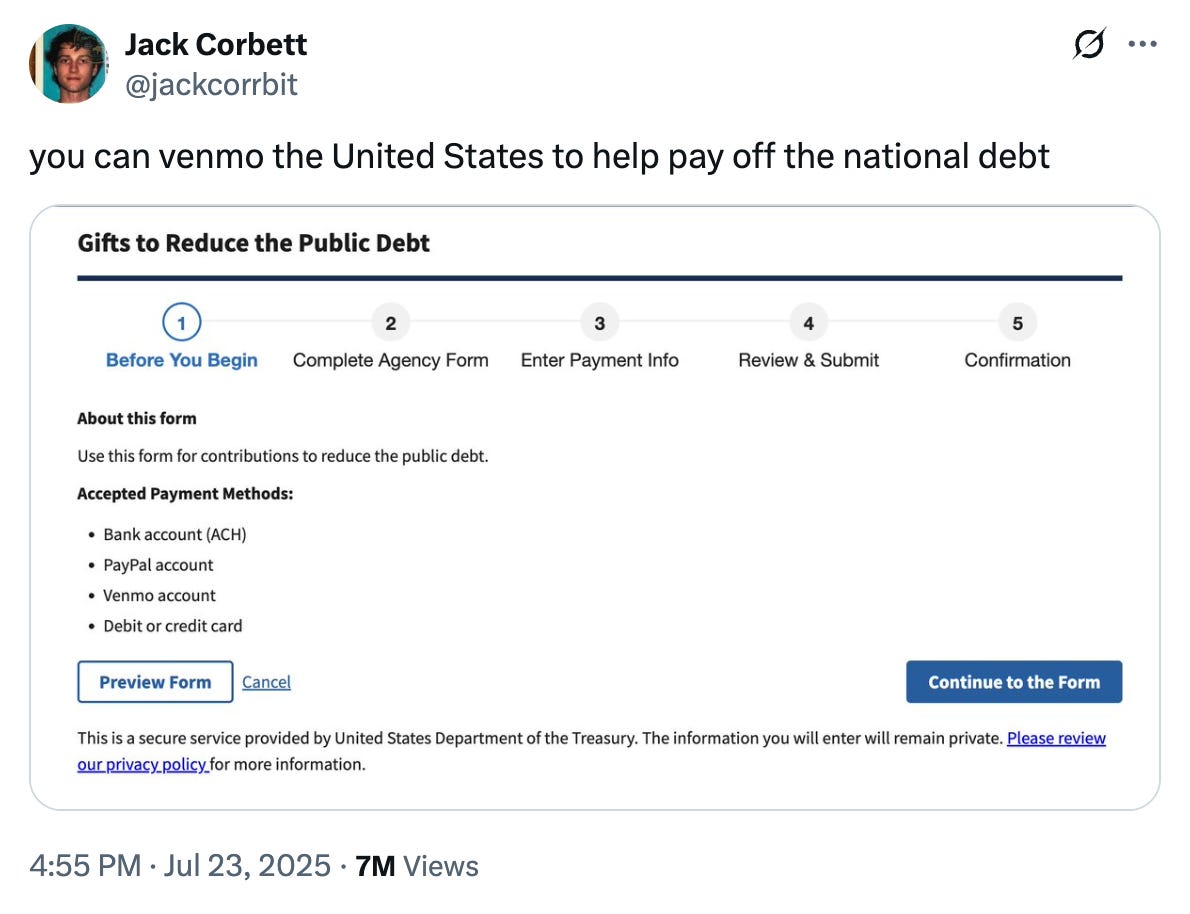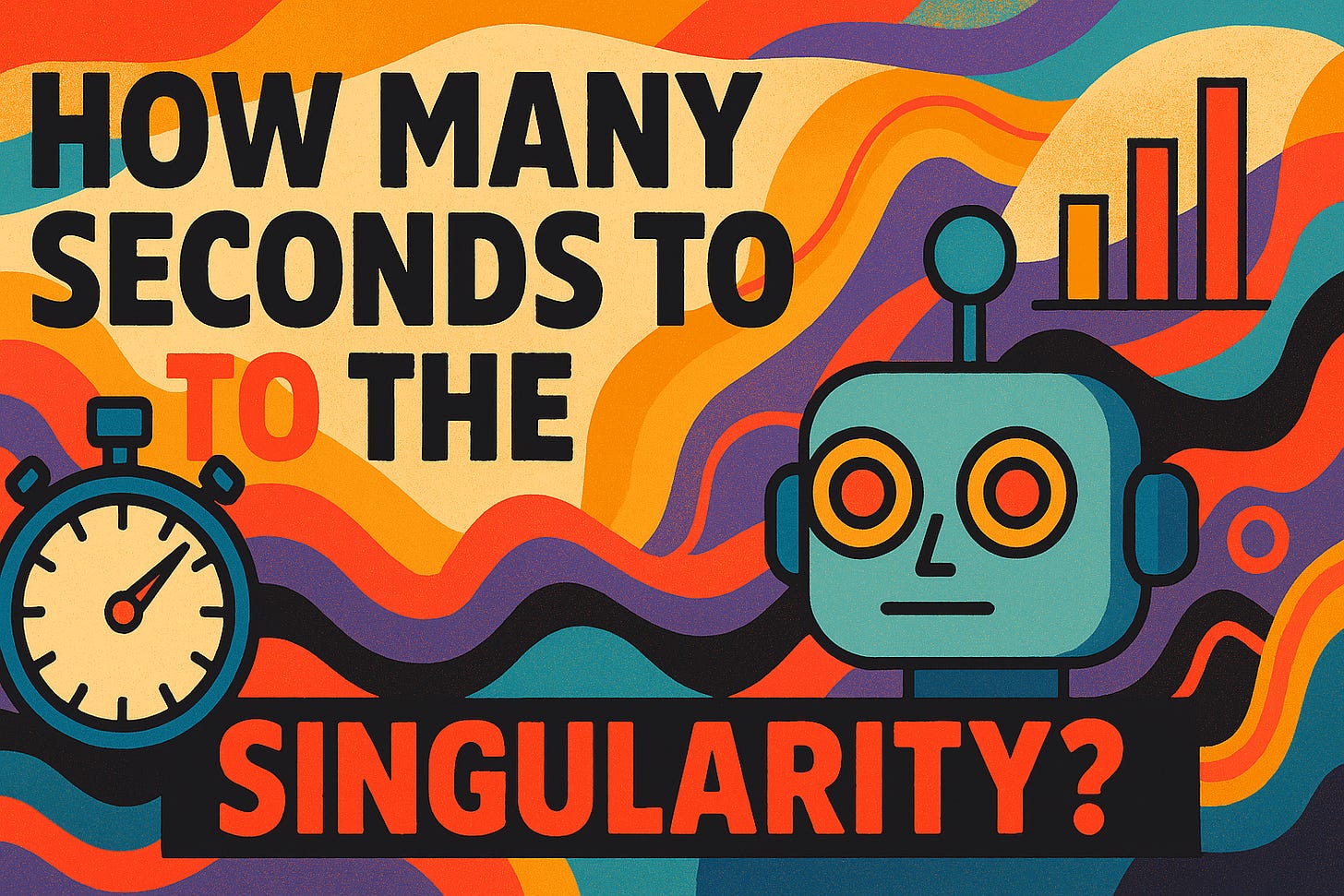Notes from the edge of civilization: August 3, 2025
Venmo the empire; programmable pricing = programmable behavior; how many seconds to the Singularity; the coming cognitive caste system.
This week, a 25-year-old NPR reporter and producer for Planet Money's TikTok account went viral on X by noticing you can send the government a gift via Venmo.
That’s right. If you’re feeling charitable and patriotic, you can help the government pay off the national debt with just the click of a button. What’s next? A GoFundMe for Social Security, and a Kickstarter for Medicare?
As it turns out, the program Jack Corbett made famous this week — known as Gifts to Reduce the Public Debt — has actually existed since 1961, when gross federal debt stood at approximately $289 billion. (Should have paid it off back then!)
Americans have apparently tried bailing out the federal government with something other than tax dollars for centuries. It started with an anonymous $5 gift in 1811 (roughly $100 today) and has since included a bag of gold bullion in a manila envelope and dimes taped to a piece of paper. Venmo just brings things up to date.
Axios tried a test run on Venmo so you don’t have to, going right through the process save for clicking the final "submit" button. It took them 80 seconds, during which time the national debt would have increased about $4.4 million.
As the Venmo form caps donations at $999,999.99, that means any gift a user gives wouldn't be sufficient to cover the increase in the debt incurred while they were donating.
In fact, you'd have to make that maximum donation in 18 seconds or less just to keep up with the debt.
The Treasury admits the program was never meant to raise real money. Total donations since 1996 equal $67.3 million and the most ever donated in one year was $20 million in 1994. In 2022, that number was just $1 million.
Look on the bright side, at least collapse now has its own convenient QR code.
The video above shows something shoppers in Europe are getting used to seeing — prices that change right before their eyes. “We lower the prices maybe 10 cents and then our competitors do the same, and it kind of gets to [be] a race to the bottom,” Partap Sandhu, the head of pricing for a major Norwegian supermarket chain, told the Wall Street Journal this week.
But what happens when that race flips directions?
Electronic shelf labels are replacing paper tags in stores across Europe and now in the US as well. Retailers like Lidl, Kroger, Walmart, and Whole Foods swear they’re only using digital tags for markdowns, convenience, and environmental reasons (less paper, don’t you know!). It’s definitely, absolutely, pinky-promise not about dynamic or surge pricing.
US lawmakers including Elizabeth Warren raised an alarm last year, warning that these tags could be used for real-time price hikes during peak shopping hours or bad weather. Because if Uber can charge you more when it rains, why not charge more for milk during a snowstorm? Retailers say that’s not the plan… yet. But plans change, so be on the lookout.
Walmart execs bragged at a recent conference about how easy it is to update shelf prices now. What used to take hours now takes seconds. So if something starts flying off the shelves — or trending on TikTok — don’t be surprised when the price follows. And with all the personal data being collected on us right now, a world where ice cream costs more while your kid is crying is just around the corner.
This isn’t just about efficiency gains at the grocery store. It’s about conditioning consumers to accept fluid, personalized pricing in both the virtual and physical realms. It’s about tracking demand, measuring reaction, and using dynamic environments to nudge, reward, or punish behavior in real time.
Remember that picture of the future: a “boot stamping on a human face — forever” suggested by George Orwell? Maybe he wasn’t only referring to the violence of the state; maybe he was also referring to the entire system that runs our lives… where even when grocery shopping for your family you can’t for a moment ignore your status as servile to a nameless faceless power extracting every last ounce of life from your being. God help us all.
If you’ve ever screamed at your phone after Google Translate butchered your attempt to ask for the bathroom in Vietnamese, good news: machines are getting better. So much better, in fact, that some people now believe we can time our inevitable descent into techno-servitude by tracking how long it takes for a human to clean up after them.
Welcome to the “Time to Edit” (TTE) metric — the countdown clock to the Singularity, according to an Italian translation firm creatively named Translated. The premise is this: language is hard. So hard, in fact, that it's often cited as the final frontier for AI — the litmus test for true Artificial General Intelligence. If a machine can understand nuance, idiom, sarcasm, and the glorious inconsistencies of human speech, then maybe — just maybe — it’s starting to think.
Translated’s CEO, Marco Trombetti, thinks we’re pretty close to that moment. The company has been tracking how long it takes for a professional human editor to fix AI-generated translations compared to human-translated ones. In 2015, it was around 3.5 seconds per word; as of 2022 it’s now just 2 seconds. Trombetti says at this rate, AI will match human translation speed by the end of this decade.
Translated’s accomplishment is impressive in the way that teaching a parrot to recite Shakespeare is impressive. The performance might be convincing, but let’s not pretend Polly understands nuance.
And yet, here we are — using a slowly shrinking number of seconds as a proxy for the rise of machine consciousness. Worse, celebrating it as if it’s some kind of monumental accomplishment to snuff out the very reason we were scattered around the earth speaking different languages. That’s playing with fire, in our books.
So yes, the clock might be ticking, but the real singularity — if it ever comes — won’t arrive with better translation speeds. It’ll come when we stop being able to tell who did the translating in the first place. And by then it’ll already be too late.
In his latest techno-prophecy, Meta CEO Mark Zuckerberg declared that anyone not wearing AI glasses in the near future will suffer a “significant cognitive disadvantage.” Translation: obey the machine, or be out-evolved by those who do.
These glasses are Silicon Valley’s trojan horse for normalizing full-spectrum, always-on surveillance marketed as “personal super-intelligence.” They watch what you see, listen to what you say, and filter your life through a privatized algorithm pretending to be your friend. They’re the ocular version of Bee, which we covered last week. Why wear your wiretap on your wrist when you can wear it on your face?
As yet, no company has been able to make money on AI glasses, but who cares when the endgame is control? Profit comes after you’re fully owned.
Zuckerberg is building a future where “keeping up” means plugging in, and “falling behind” means choosing not to let Big Tech sit on your nose and whisper in your ear.
Just remember: when they say “you’ll be at a disadvantage,” they’re not offering help, they’re issuing a warning.
Stay human, friends.
With all the purposeful distraction this week as the world marches closer to war, we say: move over Sydney Sweeney — these kids have really good jeans genes!







Is it just me, or is there anything wrong with the picture of the whiz kids who beat the Chinese team in Physics? Did China REALLY lose? Maybe I am just seeing things.
I think Zuckerberg looks a bit goofy with his monster glasses on. It's a cognitive dissonance alright, if he thinks the wearers are better off. But maybe he thinks we want to be surveilled, while living in a dream world like him. Or maybe he has a lot of disposable income?